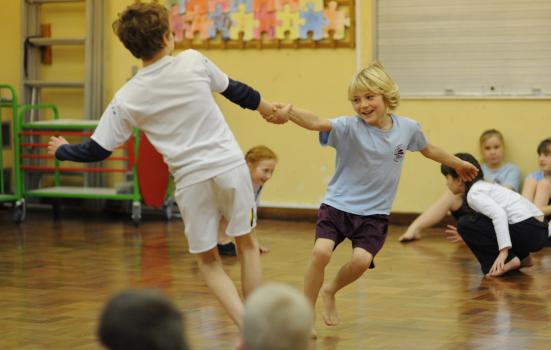Our lecture today was based around creative dance and the role we as teachers play in it. As Zara explained, Curriculum for Excellence has stated that our role is to teach children to create perform and appreciate dance.Children tend to be more proud of something that they have created themselves.
Our role as teachers is to provide children with the 10 basic dance skills as these are needed for them to be able to progress. By allowing children to explore different movements, this will in turn them to build confidence within their own talents.
We were asked to create a game based on a dance we had created like the example shown on the lecture slides.
Our dance workshop started off with the warm up games we created during the lecture including Christmas tree tig, reindeer tig and magic rocks. We then stretched our muscles to heads will roll music and incorporated dance moves from thriller. It is important to include cardio exercises and stretches into warm-ups especially when working with children.
However, Zara stated “There is nothing wrong with putting on a just dance dvd if you are struggling to come up with your own warm ups.”
We then moved onto the dances that were created last week using the 10 basic steps. We were asked to incorporate a beginning position, changing of position at least once, a choreographic device such as a cannon and an end position. This relates to the experiences and outcome: I am becoming aware of different features of dance and can practise and perform steps, formations and short dance. EXA 1-10 (Education Scotland, 2017).
We were asked to incorporate a beginning position, changing of position at least once, a choreographic device such as a cannon and an end position. This relates to the experiences and outcome: I am becoming aware of different features of dance and can practise and perform steps, formations and short dance. EXA 1-10 (Education Scotland, 2017).
The majority of the session was to practice the combination we had put together in the previous session and then we moved onto working out further details of the dance. This included how we would enter and return from the semi circle after performing our own dances and how we would get into lines to perform the routine as a whole class. The last 15 minutes of the session were spent practising the routine as a whole ready for next week.
The music session was spent exploring tuned percussion instruments and playing the glockenspiel.  We worked through a powerpoint on tuned percussion donated by a colleague our lecturer previously worked with. This powerpoint focused on learning to play the different notes in a c scale. The end of the session was spent doing improvising on the glockenspiel (as shown below) using a pentatonic scale so whatever tune was played it could not sound bad.
We worked through a powerpoint on tuned percussion donated by a colleague our lecturer previously worked with. This powerpoint focused on learning to play the different notes in a c scale. The end of the session was spent doing improvising on the glockenspiel (as shown below) using a pentatonic scale so whatever tune was played it could not sound bad.
During the workshop, we also looked at building up to using conventional notation. One of the core benefits of teaching music in the classroom is ability to develop the skill of reading music which in turn enables children to develop their concentration skills (Rimmer Music, 2017).
There are endless reasons for incorporating expressive arts into everyday teaching within the classroom!
Reference List
Education Scotland (2017) Benchmarks: Expressive Arts [Online] Available: https://education.gov.scot/improvement/Documents/ExpressiveArtsBenchmarksPDF.pdf [Accessed: 19th November 2019].
Rimmers Music (2017) The Benefits of Tuned Percussion [Online] Available: https://www.rimmersmusic.co.uk/blog/2017/12/the-benefits-of-tuned-percussion/ [Accessed: 19th November 2019].
